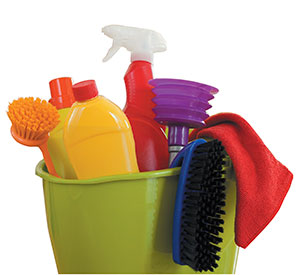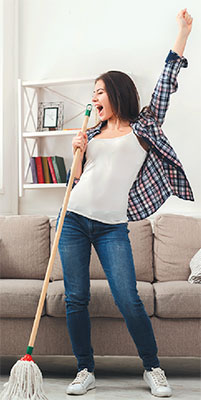
Earth Day inspires women in the Triangle to live greener. Some of us create our own house cleaners from basic ingredients, which scores the environmental hat trick: It's better for the environment; it protects us from dangerous chemicals found in many commercial products; and it saves money.
From our pals at Consumer Reports, the national nonprofit magazine, here are tips for creating your own cleaning concoctions from everyday items in your pantry.
 1. Freshen up
1. Freshen up
Make your own air freshener using one teaspoon of baking soda, one teaspoon of vinegar (or lemon juice) and two cups of hot water. Pour mix into a spray bottle and spritz away. (White vinegar has a slight scent while wet, but leaves no odor after drying.)
2. All-purpose cleaner
Soapy ammonia is a versatile cleaning agent. You can use it in place of a commercial all-purpose cleaner for everyday kitchen and bathroom cleaning. Dilute according to the instructions on the container.
3. Window and glass cleaner
Just add three tablespoons of vinegar per one quart of water in a spray bottle and you have a safe, eco-friendly window cleaner. Some recommend using half vinegar and half water.
For extra-dirty windows try this: half a teaspoon of liquid soap, three tablespoons of vinegar and two cups of water. Shake well. The best way to get streak-free windows? Use newspaper instead of paper towels to wipe them.
 4. Stains and spots
4. Stains and spots
Cream of tartar, a baking ingredient, lifts stains from sinks and tubs and removes spots from aluminum pans. A mild alternative to chlorine bleach, it can be used for stain removal as well as mild bleaching and killing germs. Cream of tartar is available in supermarkets.
5. Grime and grease
Use baking soda to clean up in the kitchen. For a "soft scrub" for countertops, mix baking soda and liquid soap until you get a consistency you like. Make only as much as you need, as it dries up quickly.
To clean extra-greasy ovens, mix one cup of baking soda and a quarter cup of washing soda, then add enough water to make a paste; apply the paste to oven surfaces and let soak overnight. The next morning, lift off soda mixture and grime; rinse surfaces well (gloves are recommended as washing soda may irritate skin).
6. Borax in the bathroom
Sold in most grocery stores, borax is a water softener and sanitizer. For a good
all-purpose bathroom sanitizer, mix two teaspoons of borax, four tablespoons of vinegar, and three to four cups of hot water in a spray bottle.
For extra cleaning power, add a quarter teaspoon liquid soap to the mixture. To clean your toilet bowl, pour one cup of borax into the toilet before going to bed. In the morning, scrub and flush. For an extra-strength cleaner, add one quarter cup vinegar to the borax.
7. Wood furniture cleaner
Pour six teaspoons light olive oil and three cups distilled white vinegar into a one-quart spray bottle and blend well. Spray the cleaner onto wood, wipe over a damp cloth and finish drying with a clean, lint-free cloth.
A few warnings
- Don't mix chlorine bleach with toilet-bowl cleaner or ammonia as it could produce dangerous fumes. Don't mix bleach with vinegar because the combination increases the potency of bleach, which could damage certain materials.
- Add water to a bucket or spray bottle first, then pour in ammonia, bleach or other items. This way there's less chance that the caustic material will fly out if there's splash-back.
- If you usually use contacts, wear glasses instead when handling these products since contacts can absorb vapors, causing irritation or damage.